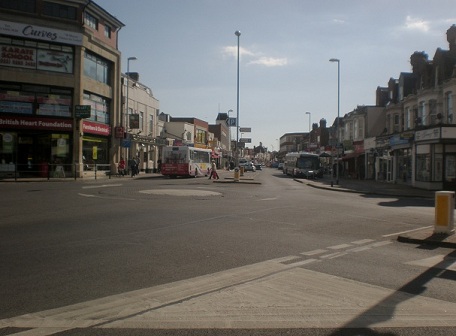By Tim Lambert
Dedicated to Steve and Jane Skinner
Early North End
In the Middle Ages, a village existed at the end of Kingston Crescent. It was called King’s tun, which meant king’s estate. In the 17th century houses were built north of the village. The new area was called ‘the north end of Kingston’. Later it was called ‘the North End’ and then just ‘North End’. The name The North End of Kingston was first recorded in 1699.
Nearby on the site of Rudmore roundabout was a pond called Reed Mere (mere was the old word for pond). It is believed Stamshaw takes its name from stam, which was a wooden post used to mark the boundary of land and an old way of spelling shore. So it was the stam shore or shore with a stam.
From the mid-18th century well-off people such as naval officers built houses at Kingston. It was a fashionable area because it was outside the noise and dirt of Portsmouth. On the other hand, it was easy to travel to work in the town by horse and carriage.
The Blue Anchor and the Green Posts were old coaching inns. Stagecoaches would stop there on their way from Portsmouth to London.
Near Kingston was a village called Buckland. It was originally called Boche (book) land. In Saxon times any written document was called a book. If the king or a rich lord granted his servant land with a written document it was called book land. In time the name changed to Buckland.
In the 19th century, Portsmouth grew across Portsea Island. In the 1860s growth spread to Rudmore and engulfed the village of Buckland. In the 1870s and 1880s, it spread to Stamshaw. In 1900 somebody said that Stamshaw was ‘poor but rigorously clean’.
In 1865 a horse-drawn tram began running along Kingston Crescent. However, North End remained undeveloped until 1881. In that year a horse-drawn tram began running between Portsmouth and Cosham.
In those days before cars, people who did not own a horse and carriage had to live within walking distance of their work. Once horse-drawn trams were running along London Road middle-class people could live in North End and travel to work in Portsmouth. As a result North End rapidly became built up. In the early years of the 20th century, trams were electrified. There was a depot for trams at the southern end of Gladys Avenue. However, the trams in Portsmouth closed down in 1935-36.
Many naval officers were living in North End at the beginning of the 20th century. So many lived in Laburnum Grove that it was called Brass Button Alley. It was also called Lavatory Lane because the white tiles on the outside of houses looked like those on the walls inside public lavatories.
At the end of the 19th century, Copnor was still a village separate from Portsmouth. Its name was once Coppsanora. Coppsa was a Saxon man and ora meant a shore. In Saxon times people added an ‘n’ to a person’s name instead of an apostrophe ‘s’. So Coppsanora means Coppsa’s shore.
Modern North End
In the 1900s as Portsmouth grew Copnor was swallowed up. Growth also spread north to Hilsea. (Hilsea’s name is probably derived from Hollis ea, which meant the island or dry land surrounded by marsh with holly trees).
Most of the roads in North End are named after towns and villages. However, Malthouse Lane is named after a malthouse, where barley was made into malt. Twyford Avenue was named after a man named Samuel Twyford who owned land in the area. Newcomen Road is named after Thomas Newcomen who invented a kind of steam engine. Winstanley Road is named after Henry Winstanley who built the first Eddystone lighthouse in 1699.
Stubbington Avenue was named after Stubbington Farm, which stood on the site. Pitcroft Road is named after Pitcroft Field. Balfour Road is named after Balfour, a prime minister from 1902-1905. Beresford Road is named after Admiral Beresford (1846-1919).
Gladys Avenue is named after a woman named Gladys White. Derby Road is named after a politician, Lord Derby. Powerscourt Road is named after a rich landowner.
College Park is named after Winchester College which owned the land. In 1915 they donated the land to be used as a park.
St Marks Church was built in 1874. St Nicholas Church was built in 1928. It was designed by Arthur Cogswell, the same man who designed The Fountain, The Lord Chichester, and the Coach and Horses.
In the 1920s and 1930s, North End became a prominent shopping centre. The first cinema in North End opened in 1923. The Odeon opened in 1936. However, it closed in 2008.
North End was hit by several bombs in 1940-41. The first time was on 11 July 1940 when a bomb hit Lyndhurst Road. Bombs fell on Chichester Road, Powerscourt Road, and Kirby Road in 1941.
However, after the Second World War life returned to normal and North End is now a busy shopping centre.
